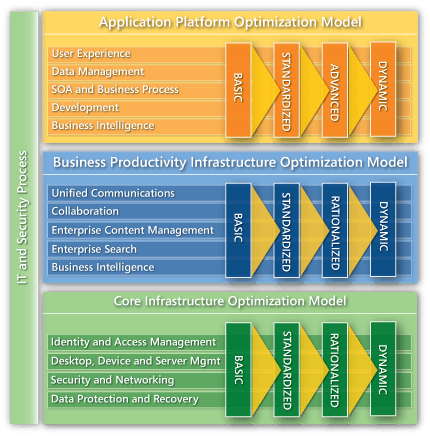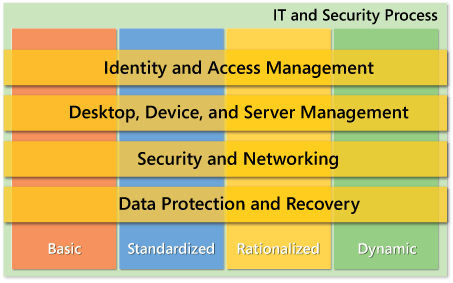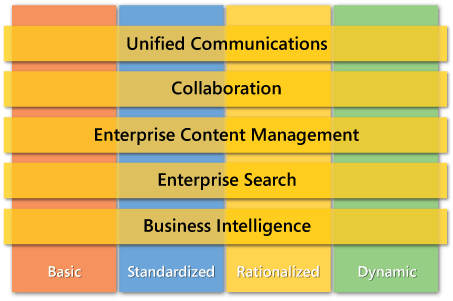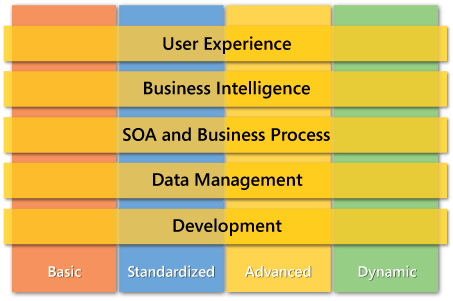Infrastructure optimization

Infrastructure optimization is Microsoft's structured, systematic process for assessing an organization's IT infrastructure and application platform across capabilities in order to provide an optimization roadmap toward a Dynamic IT. The roadmap helps companies to define and implement optimization initiatives that will enable proactive, IT management and deliver cost[1] and risk reductions across the IT organization.[2] These optimization initiatives also enhance user needs and user experience in order to increase productivity and amplify the impact of employees. Optimization enables a business to realize the full value of its IT infrastructure and platform investments and establishes IT as a strategic business asset that can facilitate innovation and help organizations respond quickly to change.
In order to help customers assess the effectiveness and potential of their IT infrastructure and application platform, create agility, and reduce costs, Microsoft has developed three Optimization models based on industry and analyst work. The Optimization models are vendor agnostic, "All of the up-front questions are about general technologies, not specific products."[3] Optimization can be viewed in three perspectives:[3]
- Core Infrastructure
- Business Productivity Infrastructure
- Application Platform
Optimization Models
The Microsoft Optimization models have been developed using industry best practices and Microsoft’s own experiences with its enterprise customers. A key goal for Microsoft in creating the models is to develop a simple way to use an Optimization framework that is flexible and can easily be used as a benchmark and a road map for technical capability and business value. Each Optimization model includes specific technical capabilities that provide a comprehensive set of solutions to help advance a customer’s infrastructure and platform Optimization levels.
Core Infrastructure Optimization Model
The Core IO model, considered the most developed of the three models,[4] helps an organization better understand and move toward a more secure, well-managed, and dynamic core IT infrastructure that will help reduce overall IT costs, make better use of IT resources, and make IT a strategic asset for the business. This model supports IT professionals in the management of servers, desktops, mobile devices, and applications, and in achieving efficient resource usage to help eliminate unnecessary cost and complexity, ensure that the business is always up and running, and establish a responsive infrastructure.

The Core IO model defines five capabilities that are required to build a more agile infrastructure. In addition, sub-capabilities are aligned to relevant capabilities to provide additional insight into solution area opportunities.
Core IO Model Capabilities
Identity & Access Management: This capability describes ways an organization should consider managing people and asset identities, solutions that should be implemented to manage and protect identity data (synchronization, password management, and user provisioning, to mention few), and how to manage access to resources from corporate mobile users, customers, and partners outside of a firewall.
Desktop, Device, and Server Management: This capability describes how organizations should consider managing desktops, mobile devices, and servers as well as how to deploy patches, operating systems, and applications across the network. It also provides guidance on how to leverage virtualization and branch office technologies to improve the IT infrastructure.
Security and Networking: This capability describes what organizations should consider implementing in their IT infrastructure to help guarantee that information and communication are protected from unauthorized access. This capability also describes mechanisms to protect IT infrastructure from denial attacks and viruses while preserving access to corporate resources.
Data Protection and Recovery: This capability provides guidance on structured backup, storage, and restore management. As information and data stores proliferate, organizations are under increasing pressure to protect that information and provide cost-effective and time-efficient recovery when required. This capability provides guidance in this area.
IT and Security Process: This capability provides proven best practice guidance on how to cost-effectively design, develop, operate, and support solutions while achieving high reliability, availability, and security. While rock-solid technology is necessary to meet demands for reliable, available, and highly secure IT services, technology alone is not sufficient; excellence in processes and people (skills, roles, and responsibilities) is also needed.
Business Productivity Infrastructure Optimization Model
The BPIO model, introduced in 2007,[5] has continued to evolve and now includes a complete set of desktop and server software and services to help streamline the way organizations and their people do business while increasing IT effectiveness. The focus of Business Productivity IO is to empower people in a changing workplace with a unified infrastructure that simplifies the way people communicate, share expertise, gain business insight and find information, to manage your IT costs and complexity.

The BPIO model and associated technologies can help organizations succeed in a diverse global market, with customers, partners, and suppliers who work together across cultures and continents. It includes five capabilities required to optimize your business productivity structure. In addition, sub-capabilities are aligned to relevant capabilities to provide additional insight into solution area opportunities.
Business Productivity IO Model Capabilities
Unified Communications: Unified Communications technologies help streamline communications between people and organizations, regardless of medium, platform, device or location. By empowering end-users with a familiar set of tools, built on an enterprise-ready, scalable and easily managed software-powered architecture, Unified Communications breaks down communication silos and extends existing communications investments, while enabling business process innovation. This capability describes how organizations should consider managing and securing their messaging infrastructure to protect users from viruses, SPAM, and malware coming from other users while collaborating. As structured and unstructured data converge with other types of communications like voice, presence, and conferencing, this capability provides a framework on how IT can leverage their infrastructure to provide new (or improved) IT services that simplify how people work together
Collaboration: Collaboration technologies deliver familiar, pervasive capabilities that easily integrate with desktop productivity tools. By empowering end users with a familiar set of tools, built on a scalable, security-enhanced, and easily managed platform, Collaboration solutions from Microsoft can extend the value of your current IT investments while enabling business process innovation. This capability describes how to use work-spaces and portals to provide a productive collaboration environment where IT departments can define processes and standard solutions that can be customized to meet specific business needs. This capability also describes how infrastructure can be extended to provide social computing capabilities, integration with line-of-business applications, and federated relationship with other organizations.
Enterprise Content Management: Enterprise Content Management technologies deliver well-integrated solutions to manage the end-to-end life-cycle of a wide range of content and for streamlining collaborative business processes. This capability describes what should be considered implementing for web authoring, forms, documents, Web content management, and record management.
Enterprise Search: Enterprise Search technologies empower people to find information and expertise anywhere in the organization. By optimizing the Enterprise Search capability, IT professionals can manage, secure, scale, and extend search as an integrated part of a broader information management infrastructure. This capability describes how organizations should consider integrating information with standard search capabilities that take into consideration different formats, data sources, and line-of-business applications from a centralized and standard infrastructure.
Business Intelligence: Business Intelligence technologies provide easy-to-use information directly where individuals work, collaborate, and make decisions. This capability includes reporting, analysis, and performance management technologies that can improve business insight by allowing IT department to define standard reports, methodologies, and metrics that can be exposed and accessed by users in a rich user interface and based on roles to assure that information is available to people with the right set of permissions.
Content Creation: Rich, open, reusable content lies at the heart of business productivity - Gartner predicts that by 2013, more than 25% of content that workers see in a day will be dominated by pictures, video or audio. The cycle of content from authoring rich content, sharing and repurposing it across the enterprise across multiple devices and connecting it with line of business information is how organizations operate today. Great collaboration within the enterprise is often on the basis of great content. Tagged, relevant content lies at the heart of your content management system.
Application Platform Optimization Model
The APO model enables organizations to drive the business forward by quickly delivering connected, flexible, and highly secure applications. It provides a user-centric experience, helping amplify the productivity and efficiency of your employees and improving the customer experience; fast and easy integration across existing software and new Web-based applications; and the ability to connect mission-critical applications while providing Internet-class scalability and robust performance.

The APO model defines five capabilities that are necessary to build a more agile application platform. In addition, sub-capabilities are aligned to relevant capabilities to provide additional insight into solution area opportunities.
Application Platform Optimization Model Capabilities
User Experience: This capability defines how user experience should be included as part of design and development of applications to improve usability of applications while providing a richer interface regardless of what platform the application is being developed for (Web, rich client applications, smart devices and more).
Business Intelligence: The Microsoft vision for Business Intelligence (BI) is to help you improve your organization's success by providing business insights to all employees leading to better, faster, more relevant decisions. Key investment areas for BI include performance management, collaboration, visualization, analysis and reporting, data mining, data integration, data warehousing, and development.
Service-Oriented Architecture (SOA) and Business Process: Business Process Management (BPM) technology integrates heterogeneous systems (Enterprise Application Integration or EAI) between organizations and trading partners and manages processes (such as BPM) that span people, partners, and software services.
Data Management: This capability describes things that should be considered when implementing an integrated data management and analysis solution that can enable your organizations to reliably manage mission-critical information and confidently run today's increasingly complex business applications.
Development: This capability addresses the needs of information technology decision makers and developers working alone or in teams to deliver high quality, secure applications that connect business processes.
Levels of Optimization
Within each model, there are four Optimization levels: basic, standardized, rationalized/advanced, and dynamic.[3] "Improving infrastructure maturity revolves around three very important aspects - technology, process and people."[6]
Basic Infrastructure
The basic infrastructure (IT) and platform is characterized by manual, localized processes; minimal central control; and non-existent or unenforced IT policies and standards regarding security, backup, image management and deployment, compliance, and other common IT standards. There is a general lack of knowledge regarding the details of the infrastructure and platform that is currently in place and which tactics will have the greatest impact to improve upon it.
The overall health of applications and services is unknown due to a lack of tools and resources. Data is stored in file shares and personal drives with disparate search tools. Records management is through manual, paper-based processes. There is no vehicle for sharing accumulated knowledge across IT.
Customers benefit substantially by moving from a basic level to a standardized level—dramatically reducing costs through developing standards, policies, and controls with an enforcement strategy, automating many manual and time consuming tasks, adopting best practices, and aspiring to make IT a strategic asset rather than a burden.
Standard Infrastructure
The standardized infrastructure and platform introduces controls through the use of standards and policies to manage desktops and servers, how machines are introduced to the network, and the use of Active Directory directory services to manage resources, security policies, and access control. Customers in a standardized state have realized the value of basic standards and some policies, yet they are still quite reactive.
Generally all patches, software deployments, and desktop services are provided through medium touch with medium to high cost. However, they have a reasonable inventory of hardware and software and are beginning to manage licenses.
Content is consolidated and records retention is managed using disconnected repositories with basic search capabilities.
Security measures are improved with a locked down perimeter but internal security may still be a risk.
Customers benefit by moving from this standardized state to a rationalized state with their infrastructure and platform by gaining substantial control and having proactive policies and processes that prepare them for the spectrum of circumstances from opportunity to catastrophe. Service management becomes a recognized concept and the organization is taking steps to implement it.
Rationalized Infrastructure
The rationalized infrastructure and platform is where the costs involved in managing desktops and servers are at their lowest and processes and policies have matured to begin playing a large role in supporting and expanding the business. Security is very proactive and responding to threats and challenges is rapid and controlled.
The use of zero-touch deployment minimizes costs, the time to deploy, and technical challenges. The number of images is minimal and the process for managing desktops is very low touch. Organizations at a rationalized level have a clear inventory of hardware and software, and only purchase those licenses and computers they need. Document and records management and search are considered as strategic enablers for the business and are integrated with one or more business productivity infrastructure investments and IT has defined processes and procedures to provision search integration with new line-of-business applications.
Customers benefit on a business level by moving from this rationalized state to a dynamic state. The benefits of implementing new or alternative technologies to take on a business challenge or opportunity far outweigh the incremental cost. Service management is implemented for a few services with the organization taking steps to implement it more broadly across IT.
Dynamic Infrastructure
Customers with a dynamic infrastructure and platform are fully aware of the strategic value their infrastructure provides in helping them run their business efficiently and staying ahead of competitors.
Costs are fully controlled; there is integration between users and data, desktops, and servers; collaboration between users and departments is pervasive; and mobile users have nearly on-site levels of service and capabilities regardless of location.
Processes are fully automated, often incorporated into the technology itself allowing IT to be aligned and managed according to the business needs. Additional investments in technology yield rapid, measurable benefits for the business.
Customers benefit from increasing the percentage of their infrastructure and platform that is dynamic by providing heightened levels of service, competitive and comparative advantage, and taking on bigger business challenges. Service management is implemented for all critical services with service level agreements and operational reviews. Due to costs and strategic initiatives within an organization, not all IT departments will seek to reach the "Dynamic" level.[7]
Notes
- ↑ Krill, Paul. "Microsoft touts cost savings of Vista over XP". PC World. 6 September 2007.
- ↑ Barney, Doug. "Optimize sales". Redmond Channel Partner. 1 February 2008.
- ↑ 3.0 3.1 3.2 Barney, Doug. "Infrastructure Optimization for IT". Redmond. 1 January 2008.
- ↑ DeGroot, Paul. "Optimization model structures sales efforts". Directions on Microsoft. 25 June 2007
- ↑ McLaughlin, Kevin. "Microsoft infrastructure optimization campaign gains steam". ChannelWeb. 25 September 2007.
- ↑ "A practical approach to delivering ITSM". Business Management. http://compliancegoals.com/currentissue/article.asp?art=26096&issue=156[]
- ↑ Myler, Kerrie; Fuller, Cameron; Joyner, John; Dominey, Andy. System Center Operations Manager 2007 Unleashed. Sams Publishing, 2008.